Cuenca, Ecuador’s third largest city, has a lot to offer tourists who venture to its renowned streets. While most people tend to visit other Ecuadorian destinations like Guayaquil, Quito, and the Galapagos, I think Cuenca is just as fascinating. From its UNESCO-listed historic core to its Incan ruins, there’s a lot to see and do in Cuenca, which is where this Cuenca Itinerary comes in handy.
During my trip to Ecuador, I knew when I was planning my trip that I wanted to make a stop at Cuenca. I mean when a place gets a nickname such as the “Athens of Ecuador” it must be worth a stop. What I found was a city steeped in culture, rich in tradition, and bursting with life and character. It is a city surrounded by mountains and bisected by rumbling, picturesque rivers. It was one of my favorite places in Ecuador, and I’m sure you’re going to love it too.
This 1-Day Cuenca Itinerary will take you around all the must see places in Cuenca, as well as give you suggestions for places to visit if you want to extend your trip. Cuenca is a small city, so 1 day is enough to see the major sights. If you’d like to do some sightseeing at a more relaxed pace or do a day trip or two, you can do this itinerary in 2 or more days. This Cuenca itinerary will also give you some practical information you need to know before visiting Cuenca, from tips on when to visit to a short guide on how to get around the city.
By Carter LaCrosse and Stephen Tantoco
Subscribe to my Youtube channel @ Stephen Flores Travel, like me on Facebook at Passport Perspective, and follow me on Instagram / Twitter / Tiktok @StephenJFlores.
This post contains affiliate links. We receive a small commission for purchases made after clicking on these links at no extra cost to you.
Cuenca Itinerary Introduction
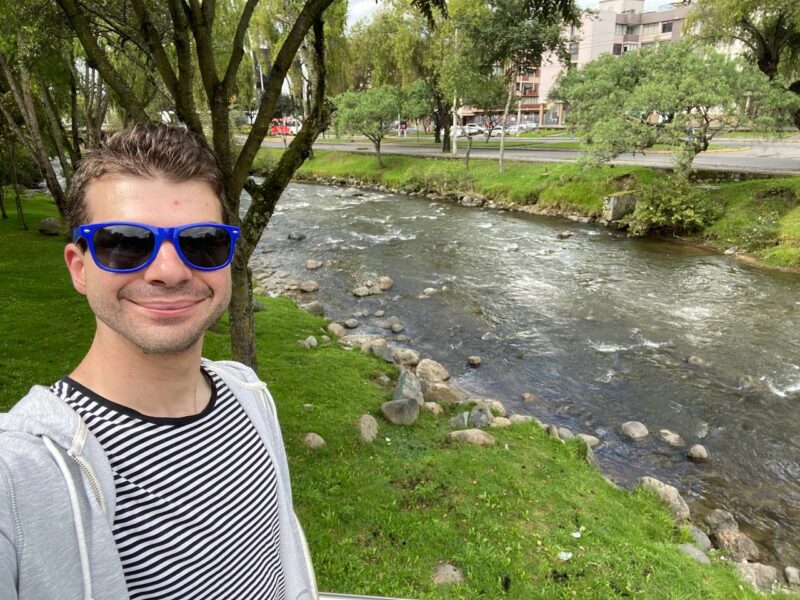
Just like our previous Ecuador itinerary covering the city of Quito, there are some things you need to know about or be aware of before you travel to Cuenca. So before we get to the meat of this Cuenca itinerary, we’re going to discuss a couple of things that will be helpful for you to know before you plan your trip to Cuenca. Let’s discuss them below.
Getting There
Mariscal La Mar International Airport is the main airport of Cuenca. You’ll find some flights here to and from Guayaquil and Quito. The airport is open from 7am to 8pm and includes shops, restaurants, and tourist services.
There are currently no international flights departing from or arriving at this airport, so you would need to connect through Guayaquil or Quito to reach this city. Personally, I would recommend you fly into Cuenca during your visit. Flights from Quito and Guayaquil are relatively cheap and you would save a lot of time by choosing to fly into Cuenca instead of taking a bus. Flights from both cities will take less than an hour to get to Cuenca.
Buses, however, are cheaper, so if you’re traveling on a budget this could be a good option for you. A bus from Guayaquil will take about 3 hours, while a bus from Quito will take about 9 hours. However, those times do not account for delays due to construction or other problems. When I visited Ecuador, the country was in the middle of protests so roads were blocked off, resulting in significant delays. Just something to keep in mind if you choose to travel by road.
Cuenca’s bus terminal is known as Terminal Terrestre and is located in the northeast of the city about 1 kilometer from the airport. It is open 24/7, has a large waiting area, and is equipped with CCTV. You can check bus schedules here.
When to Go, Climate, and Weather
With its location being up in the Ecuadorian Andes, Cuenca experiences a mild climate year round. Temperatures stay pretty consistent throughout the year, with the average temperature in the warmest month (January) being 27C or 81F and the average temperature in the cooler months being 23C or 73F.
Cuenca, like Quito, doesn’t have traditional seasons because it’s located close to the equator. It instead has a dry “season” and a wet “season”. The dry season lasts from June to September, with the wet season taking place from October to May.
I would recommend visiting in the dry season as it has slightly cooler temperatures and visiting at this time gives you a higher chance of not experiencing rain on any given day. However, still prepare for rain even in the dry season, but showers shouldn’t last longer than 15 minutes.
High Elevation
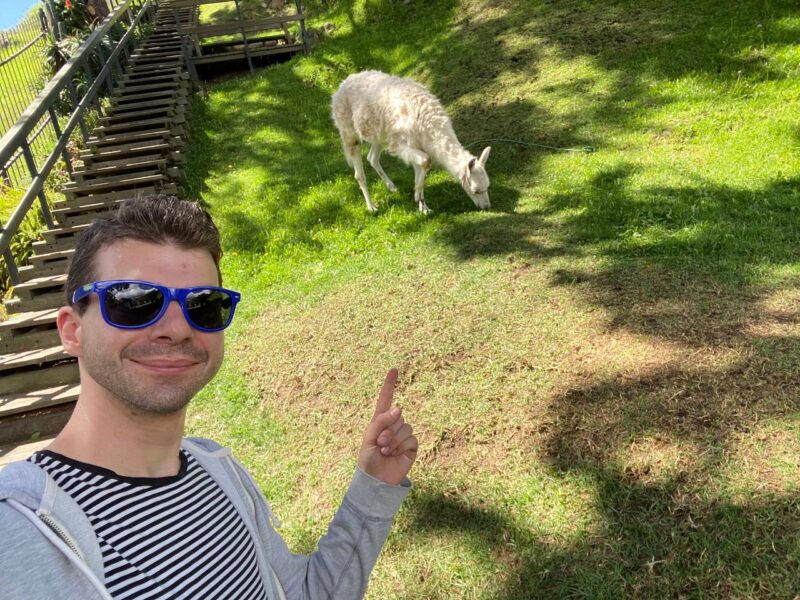
Cuenca is located at a high altitude of 2,358 meters or 8,400 feet above sea level. As such, arriving in Cuenca, especially coming from Guayaquil which is at sea level, may trigger altitude sickness in those who do not acclimate well to high altitudes.
If you’re coming from Guayaquil and are prone to altitude sickness, I would recommend spending an extra day in Cuenca to properly acclimate. If you’re coming from Quito, however, you should be acclimated to the altitude already given that Quito is also located at a high altitude.
Where to Stay
We recommend staying in El Centro as this area is where most of the tourist attractions are located. It’s also a very safe area, with Cuenca in general being very safe. Here are the hostels, boutique hotels, and full-fledged hotels we recommend you stay at during your visit, but keep in mind that the city also has some amazing Airbnb options as well.
Hostels
Mid-Range
Luxury
Money Matters
The US Dollar is the official currency of Ecuador. Much of Ecuador, including Cuenca, still uses cash. Because of this, it would be wise to keep small bills and dollar coins with you at all times. Even $20 dollar bills can be difficult to use in some small towns and in certain situations, so keeping a lot of change, including smaller coins, will certainly come in handy.
Getting Around
There are three main ways to get around Cuenca, other than walking: Public Buses, Tranvia or the Tram, and Taxis. We’ll go through each mode of transport below but keep in mind that most of the tourist sites are within walking distance from one another, so you won’t be taking public transport that much.
Public Buses
The most widespread mode of transportation in Cuenca, public buses take you to every neighborhood and community in Cuenca. However, unlike other public bus systems in other nearby towns and cities, Cuenca’s bus system works a little differently. The main difference is that you cannot pay with cash when you enter a bus. Instead, you need a bus pass to board and use the public buses.
Bus passes can be purchased at the Department of Transportation on Los Capulies Street, the ETAPA office on Gran Colombia, Terminal Terrestre Bus Station, or Terminal del Sur Bus Station. When you get there, you can buy a bus pass for $1.75 and then load it with cash. A bus ride costs about $0.30 per ride so plan to load about $3-$5 onto your card. You can reload your bus pass at these locations.
To view bus routes and see the quickest way to get from point to point, consult Google Maps. Signs on board the bus will tell you which stop is next. You can also double check that you’re getting on the right bus by looking at the windshield where the route number is usually on display. Be sure to tap your card against the reader when you get on the bus. To get off at the next station, press any of the “stop request” buttons.
Tranvia
Cuenca’s newest form of public transport, the Tranvia is a single line tram or metro that runs from the airport and goes through the Centro Historico, eventually turning south and going until Rio Tarqui. This means that, since we recommend you stay at the Centro Historico, you could take the Tranvia from the airport to your accommodation.
Unfortunately, the bus pass card does not work on the Tranvia and you cannot get a Tranvia bus card as those are reserved only for locals who live in Cuenca. Instead, you’re going to have to buy a ticket every time you ride the Tranvia. It costs $1 per ride and you can buy tickets at any Tranvia station. The Tranvia runs from 6am to 9pm every day.
Taxis
Taxis are abundant in Cuenca. It won’t be hard to find one and flag it down on the street. They are colored yellow and should be metered. If you enter a cab and find that the driver refuses to turn the meter on, calmly exit the cab and flag another one down. There are minimum fares depending on when you decide to ride a cab. It costs $1.50 for rides taking place on Mondays through Saturdays in the daytime, while fares on nights and Sundays will cost $1.75.
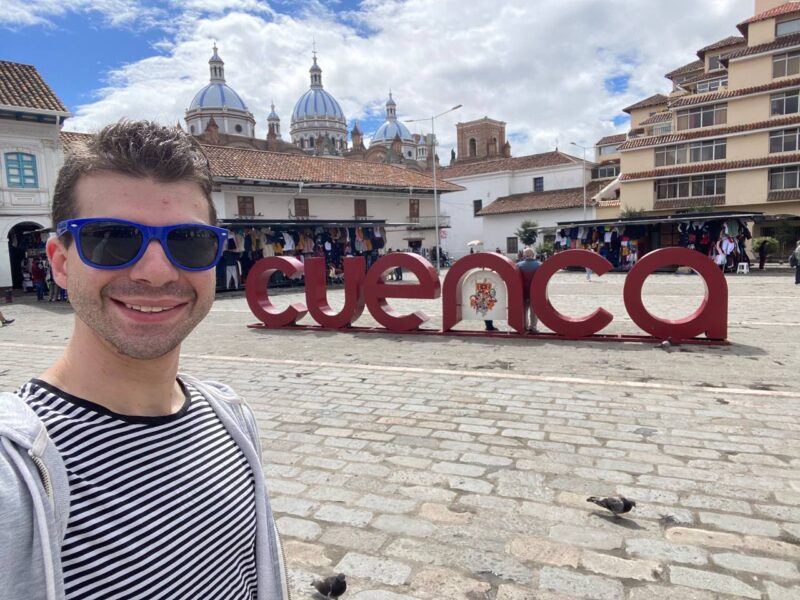
Language
Spanish is the official language of Ecuador. You may encounter a bit of a language barrier when visiting Cuenca. This Cuenca itinerary recommends that you keep a few basic Spanish phrases in your back pocket, and don’t forget to greet people in Spanish.
Safety
Cuenca is widely considered the safest city in Ecuador and one of the safest cities in South America. This is mostly due to its small size, which fosters a sense of community between its residents. However, that being said, this isn’t a reason to let your guard down. Petty theft and pickpocketing has been on the rise, so just bear that in mind. Secure all your valuables, don’t flash your phone, and keep your wallet in your front pocket, especially on public transport.
Most areas of Cuenca are safe to explore. The one minor exception would be the La Merced area, which is where the Terminal Terrestre Bus Station is located. The area has seen a rise in pickpocketing in recent years, so if you plan on traveling to or from the bus station be sure you’re vigilant and on the lookout for your belongings.
And that’s everything you need to know about Cuenca! So let’s jump straight into the Cuenca itinerary.
Day 1: Historic Center and Other Sites
Have Breakfast at Your Hotel or At a Local Cafe
You probably arrived in Cuenca last night, which means you’re recharged and ready for a day of exploring. That’s great! But we can’t start the day on an empty stomach. So eat some breakfast at your hotel or head to one of the many local cafes that pepper the streets of Cuenca. Once you’ve filled up for the day, head to the Centro Historico to begin this Cuenca Itinerary.
Visit the Centro Historico
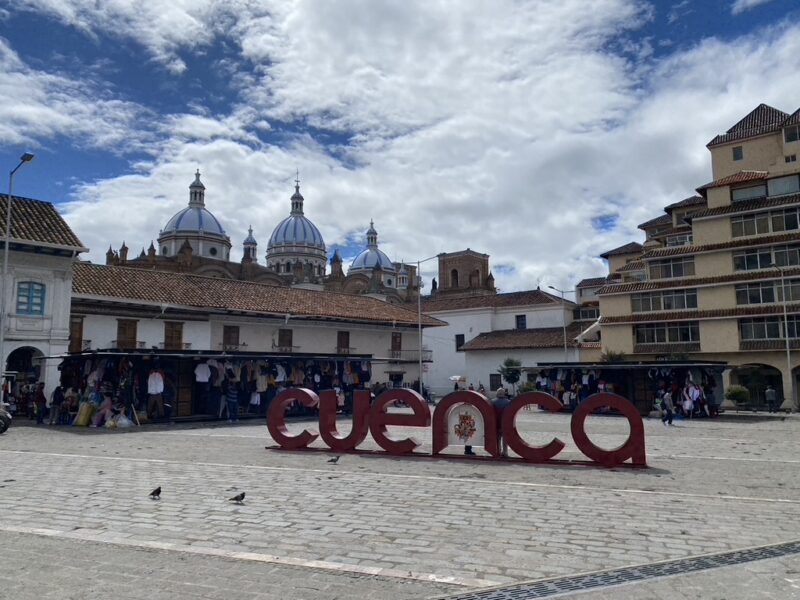
Established in 1577 on the ruins of an Incan city, Cuenca can trace its roots back to its Centro Historico. It was named a UNESCO World Heritage Site back in 1999. The Centro Historico is laid out in a grid-like manner and has some of the most beautiful buildings in Ecuador lining its cobblestone streets. Start your exploration of the city in Parque Calderon.
Marvel at Parque Calderon
The heart of Cuenca and a center of the city’s social life, Parque Calderon was named after Abdon Calderon, a war hero from Cuenca who was one of the leaders of the Ecuadorian fight for independence. He died for his country at the age of 18 and is immortalized by a memorial located at the center of the park.
The park also has a gazebo, fountains, benches, and plenty of foliage. You’ll see a lot of individuals and families enjoying the park, especially on weekends. Take a moment to sit on a bench and watch the world go by around you. This is a slice of Cuenca life that you’ll want to take in.
The park is also flanked by two cathedrals: The Old Cathedral of Cuenca and the New Cathedral of Cuenca, which is also known as the Catedral de la Immaculada Concepcion. You’ll be visiting both of these cathedrals on this Cuenca itinerary, so let’s start with the Old Cathedral.
Admire the Art in the Old Cathedral of Cuenca
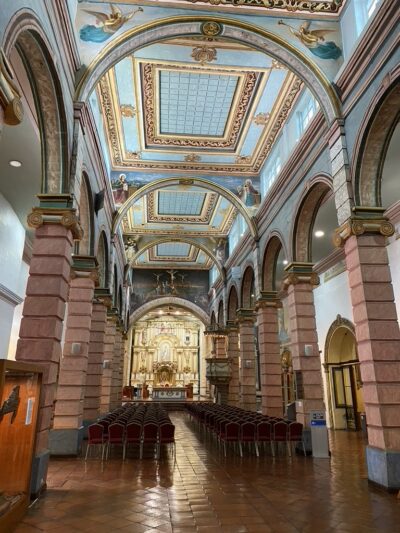
The Old Cathedral of Cuenca is, in my opinion, the less dramatic and opulent of the two. That doesn’t mean it’s not worth going to, however, as the repurposed Cathedral is now a museum with lots of art and artifacts that are worth seeing.
Also called El Sagrario, plans for the cathedral first came to light in 1557, with construction commencing a decade later. The church was operationally finished in 1573. It was built on the site of ancient Incan ruins and, at first, only the Spanish could worship in the cathedral.
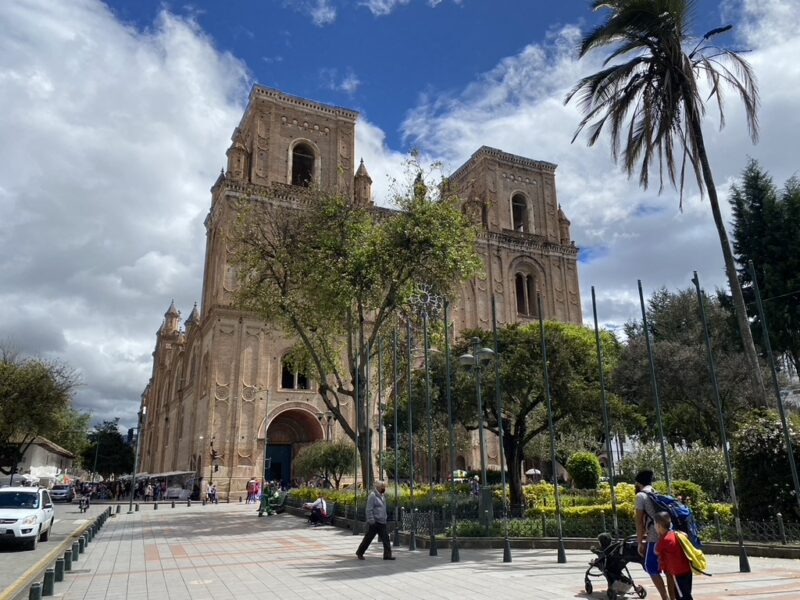
When the population of Cuenca became too large to fit in one cathedral, a second newer cathedral opened opposite the Old Cathedral. It was kept standing even after the other Cathedral was built through private donations from the Cuencan community. It is no longer consecrated, hence why it is now a museum. It’s considered a standout of Baroque-Renaissance architecture.
The cathedral houses the “Museum for Religious Art” with visitors able to explore its side chapels, view historical artifacts, paintings, and carvings, as well as explore its belltower and crypts. The signages throughout the museum have English translations on them. This is a must do attraction on this Cuenca itinerary and is a perfect introduction to the city and its history.
Step Back in Time at the Catedral de la Immaculada Concepcion
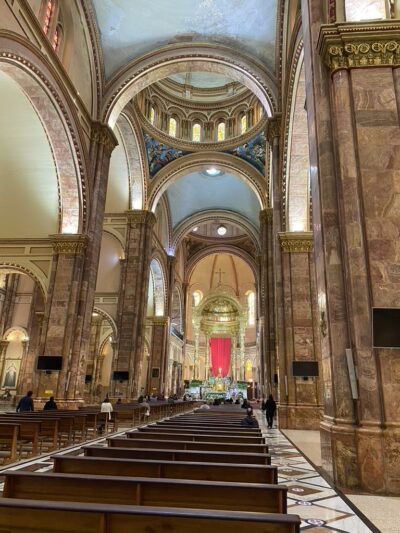
Located across Parque Calderon, Catedral de la Immaculada Concepcion is also known as the New Cathedral of Cuenca. Construction began in 1885 and finished almost a century later in 1975. It can be distinguished by its signature blue domes.
It’s Cuenca’s largest church, and one of South America’s largest as well. Its Romanesque architectural style is eye-catching, and I think it’s one of the most beautiful churches in Ecuador, if not the most beautiful church in the country.
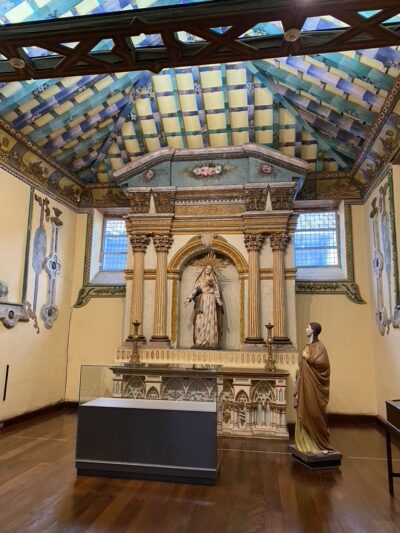
The church’s marble interiors and stained glass windows are incredibly detailed and beautiful. You’re also free to climb to the top of the tower. You’ll find a small ticket booth near the church’s right hand entrance where you can buy tickets to go up to the top of the tower. A spiral staircase will lead you there, and you’ll be rewarded with stunning views of Cuenca.
When visiting, keep in mind that this is a working church. Do not disturb worshippers and wear respectable attire when visiting the church. Be sure to explore the side areas of the church, including its many ornately decorated altars.
Discover How the Panama Hat is Made at Homero Ortega
After exploring both churches, head to Homero Ortega to learn about the history of the Panama Hat. You can reach Homero Ortega from Parque Calderon by bus. Once you arrive, head into the factory and go straight to its museum.
The Panama Hat is an “Ecuadorian toquilla straw hat” that has its roots in the Indigenous people of Ecuador who made hats using toquilla straw to shield themselves from the harsh sun. It was actually first invented in Ecuador, not Panama. It’s called the Panama Hat even though it has roots in Ecuador because of its widespread use during the construction of the Panama Canal.
Panama Hats are made by hand and have a reputation for also being a popular family heirloom. It was designated an “Intangible Cultural Heritage of Humanity” by UNESCO in 2012. At Homero Ortega, you can purchase a hat for yourself, as well as take a peek at their museum.
The museum is made up of 3 rooms: the first covers the history of the Panama hat, the second goes over how the hat is made and manufactured, and the third dives into the history of Homero Ortega. The museum ends in the shop where you can purchase your own Panama Hat. Visits to the museum come with a 30-minute guided tour.
Grab some lunch at Mercado 10 de Agosto
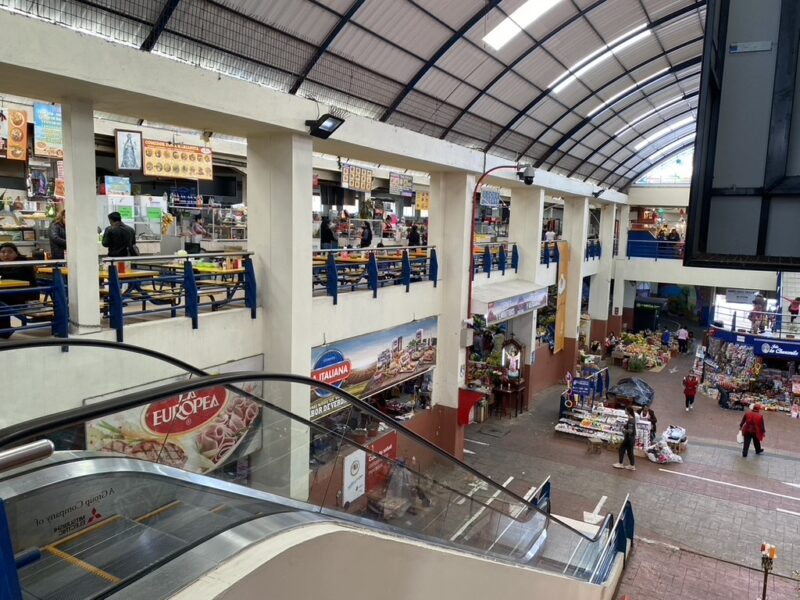
After a full morning of touring, head to Mercado 10 de Agosto for lunch! This local market sells a lot of produce, but also has a lot of local specialities as well. The most famous stall is the Doña Elsita Cardenas stall that sells Hornado. You can also find stalls selling dishes like Ceviche, Tamales, and other Ecuadorian dishes. Once you’ve had your fill, hop on the next available transport option to get to the next stop of this Cuenca itinerary: Pumapungo Museum.
Tour the Pumapungo Museum and Incan Ruins
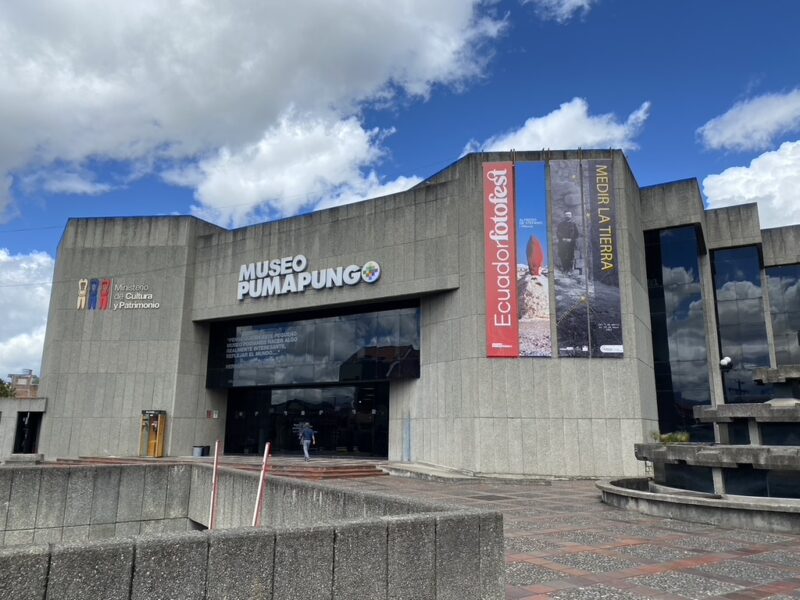
The Pumapungo museum is an ethnographic and art museum focusing on Indigenous culture. It’s the largest museum in Cuenca, and is also considered to be the best. It has two floors and is smaller than most museums, although what it contains is very significant to the history of Ecuador.
The basement contains a selection of modern art, but it’s the second floor of this museum that truly stands out. The second floor houses exhibitions chronicling the history of Ecuadorian Indigenous culture. It features intricate dioramas of the different domiciles constructed by the different indigenous groups that populate Ecuador.
The end of the museum features rare tzantzas, also known as shrunken heads, from the Shuar culture. The Shuar shrink the heads of their enemies in order to harness their spirits for strength in future battles.
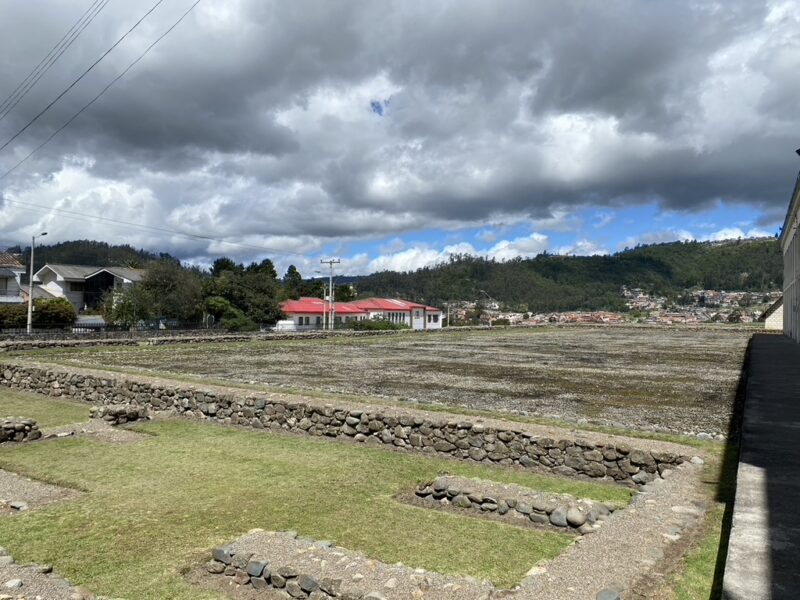
The back of the museum features some Incan ruins that used to belong to the ancient Incan city of Tomebamba. It’s not the most well-preserved ruins site because the Spanish used a lot of the bricks that used to be here to build the city of Cuenca, but it’s still fascinating to see Incan ruins in the middle of a bustling city. You may even spot a few llamas in the area.
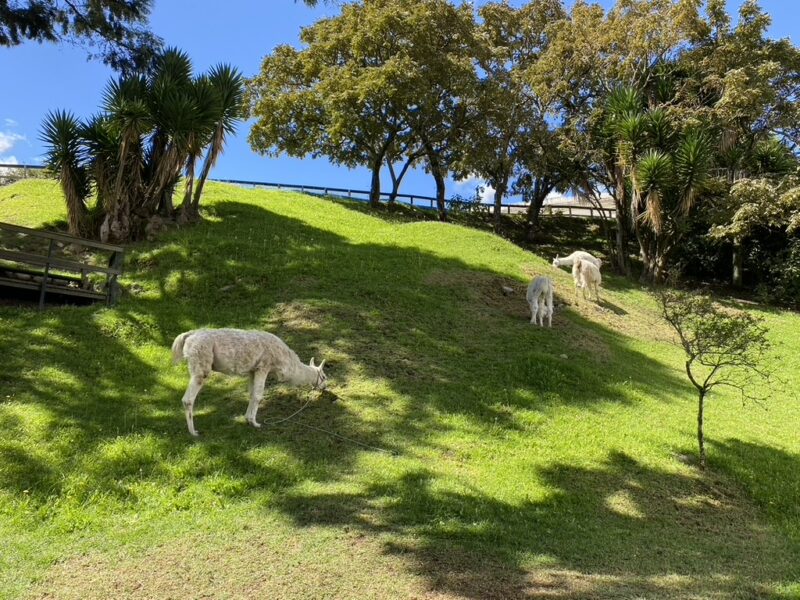
Look Out Over the City from Mirador de Turi
After seeing the ruins and the museum, head on over to Mirador de Turi (I recommend getting here by taxi) for amazing views of Cuenca and the surrounding mountains. The word ‘Turi’ comes from an indigenous word which translates to gold. The mountain used to be a special worship site for Incan Gods.
Hopefully by the time you arrive here it’s almost sunset. Sunsets from the Mirador de Turi are nothing short of spectacular, and there are other activities on the Mirador de Turi for you to explore.
You can enter the Nuestra Señora de la Merced de Turi Church. Its adobe walls and brick domes offer a peek into traditional building techniques. There is also an adventure park in the Mirador de Turi as well. It includes ropes courses, ziplines, and other fun outdoor activities. You can also marvel at the nearby Señor de Belén Statue
Whatever you decide to do, this is the perfect way to end your day in Cuenca!
Have Dinner at Guajibamba
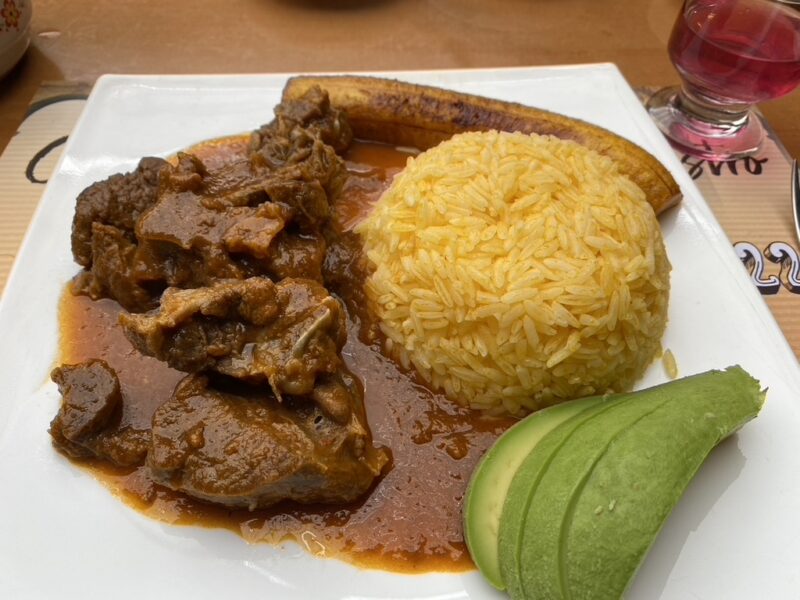
For dinner, head on over to Guajibamba. This sit-down restaurant is one of the best places in Cuenca to try traditional Ecuadorian dishes, specifically Seco de chivo, known also as goat stew, and Cuy, also known as Ecuadorian guinea pig, with Cuy being a specifically Cuencan specialty This restaurant is the most popular place in Cuenca to try Cuy, so I highly recommend having it here.
Other Things to Do in Cuenca
While everything in this Cuenca itinerary can be done in a day or two, there are some places you can go to on day trips from Cuenca. You can visit Chordeleg, a UNESCO Creative City located about a one hour drive away from Cuenca’s historic district. Chordeleg is known for its jewelry, and you can spend hours perusing its various shops.
Another possible day trip option is Cajas National Park. You can go to this place on a guided tour or by hiring a taxi driver. Popular spots to visit include Hostería Dos Chorreras or the Two Waterfalls eco-lodge, named so because of nearby waterfalls, as well as The Laguna Toreadora Loop, which is a 60-90 minute hike with stunning views.
Cuenca Itinerary Conclusion
I hope this post was helpful to you in planning your Cuenca trip! If you have any questions, feel free to send me a message.
If you found 1-Day Cuenca Itinerary helpful, consider subscribing to my newsletter to receive inspiration, tips, and insider secrets delivered straight to your inbox. Whether you’re planning your next adventure, daydreaming about far-off places, or seeking hidden gems closer to home, we’ve got you covered.
✨ Here’s What You’ll Get:
- Curated travel guides to iconic and off-the-beaten-path destinations.
- Budget-friendly tips and tips on solo traveling.
- Exclusive deals and must-know travel advice.
- Stories and trip reports to spark your wanderlust and make your trips unforgettable.
Travel smarter, deeper, and with more joy. Join our community of explorers today and never miss a chance to wander! Sign up down below!
SUGGESTED READING:

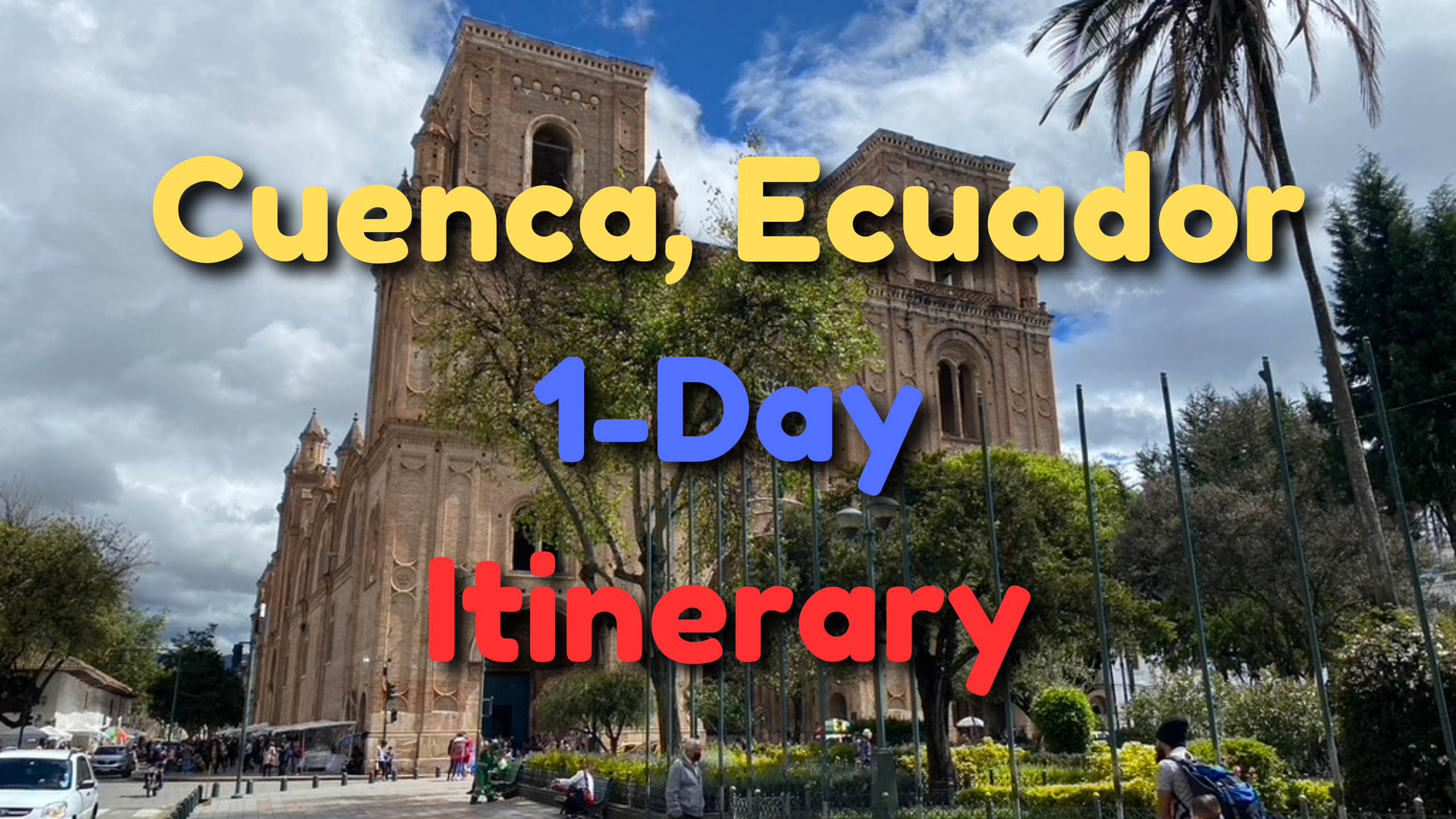
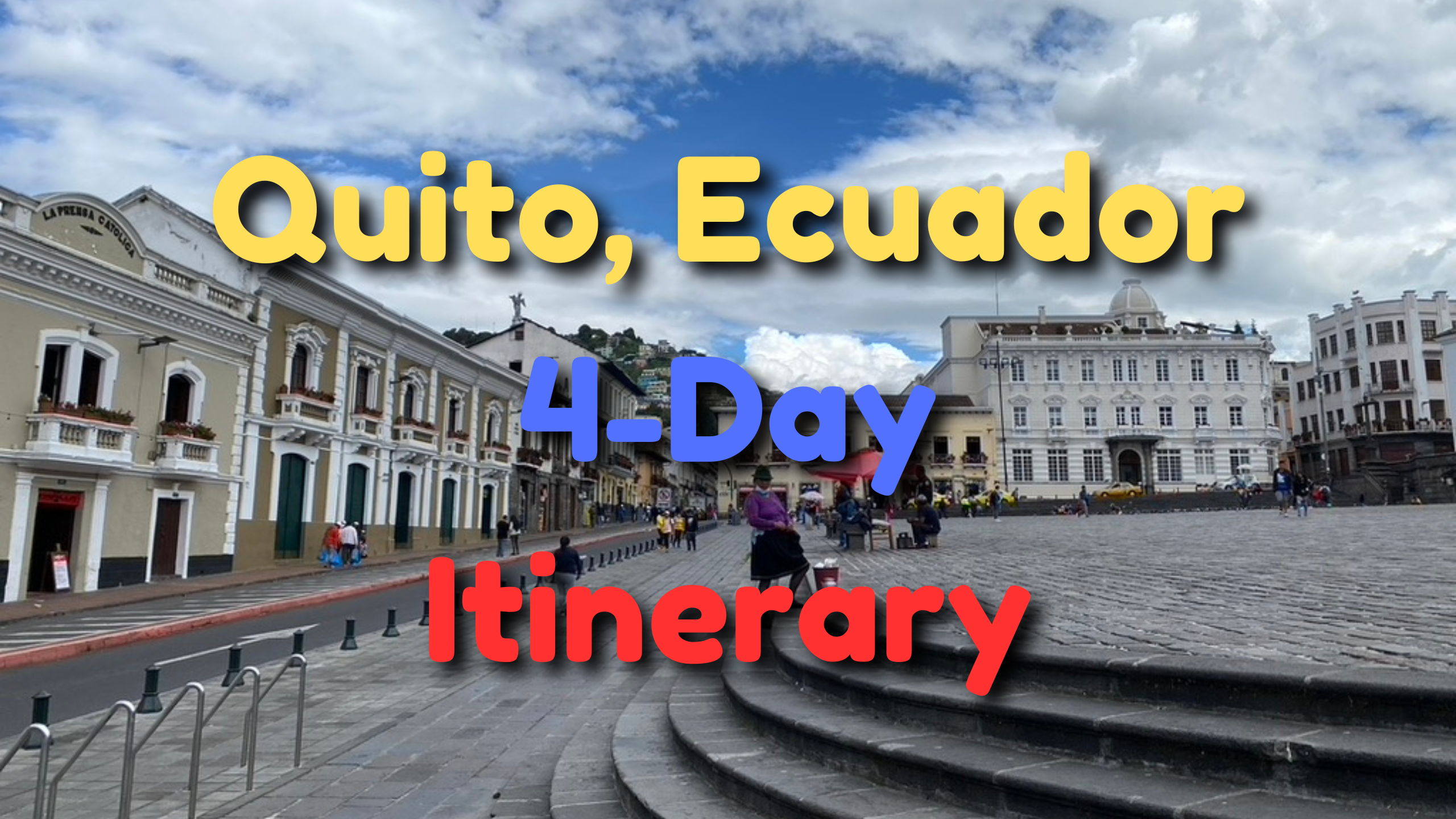

Leave A Comment